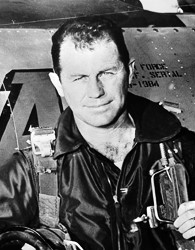Driven by an unshakable sense of duty and a love of life in the air, Chuck Yeager has spent decades pushing the boundaries of aviation and military service.
Chuck Yeager’s Early Days
Born on February 13, 1923, and raised in the hills of West Virginia near the town of Myra, Charles “Chuck” Yeager entered military service as soon as he could, joining 17 classmates who enlisted after high school graduation to fight in World War II.
After spending nearly two years working his way from a plane mechanic to a flying sergeant in bases in Nevada, California and Ohio, Yeager and his squadron were deployed in February 1944.
While his friends were sent across the globe, Yeager ended up in England, flying missions over occupied France, where he accompanied bombers in a P-51 Mustang and found himself immediately thrust onto the front lines.
Shot down in the south of France, Yeager teamed with the French Resistance to survive for weeks as he made his way over the Pyrenees into then-neutral Spain. Once back in England, Yeager appealed directly to General Dwight D. Eisenhower to sidestep military protocol, which dictated that all pilots shot down should return to the United States, and allow him to instead return to the skies.
Proving Eisenhower’s decision to be a wise one, Yeager took to the skies again, racking up an impressive record, including taking down five aircrafts in a single day, though he has been modest to point out that two planes did the work for him by colliding.
Although he avoided a pilot’s return during the war, after his tour of duty was complete Yeager did take advantage of a rule allowing all those shot down to choose which base they would return to in the United States.
Sources in this Story
- Academy of Achievement: Chuck Yeager Biography
- U.S. Centennial of Flight Commission: Chuck Yeager
- Smithsonian Institution: National Air and Space Museum: Bell X-1 “Glamorous Glennis”
- PBS: NOVA: Men of the X-1
- The Washington Post: Aloft with Check Yeager, Testy Pilot
Breaking the Sound Barrier
Deciding on Muroc Field in California, Yeager soon found himself in one of the most remote Air Force locations in the country, but also one whose unique isolation allowed the testing of the latest and fastest planes the military had to offer.
Assigned to a host of test flights, Yeager was soon selected as pilot during the Air Force’s attempt to break the sound barrier; he would fly a super-sonic plane called the X-1, nicknamed Glamorous Glennis in honor of his wife. Rocket-like and so tight and compact that it had to be dropped from a cargo plane to conserve fuel, the X-1 was America’s chance to top Mach 1.
On October 14, 1947, Yeager climbed into the cockpit with two broken ribs from an ill-advised horseback ride after a night out a few days before and set about making history.
Pushing the plane to Mach 1.05, Yeager witnessed the sky turn a “deep purple and all at once the stars and the moon came out—the sun shone at the same time…He was simply looking out into space,” according to Tom Wolfe’s “The Right Stuff,” chronicling America’s race for space exploration.
Famously modest about his own achievements and impatiently gruff in his responses to interviews, Yeager pointed out in a 2006 interview with West Virginia Public Broadcasting that the X-1 was one of many test projects he was involved in at the time and despite any historical significance, he was simply doing his duty.
However, modesty would not slow Yeager down, as he spent the next decade and a half pushing the boundaries of aviation still further, and training more than half the astronauts that would go on to fly in the Apollo, Gemini and Mercury space missions, though Yeager himself was passed over for service in the space program.
After surviving a nearly devastating crash in 1963 while flying an experimental Lockheed Starfighter at nearly twice the speed of sound, Yeager began his service in Vietnam, commanding and running missions from a base in the Philippines, and earning him the rank of Brigadier General in 1968.
After a tour helping the Pakistani air force against India in 1971, Yeager retired in 1975, though he never kept far from the runway.
The Man and His Work
The Rest of the Story
Recognized within the Air Force for his achievements, it was not until Tom Wolfe’s book was published in 1979, and the movie version was released in 1983, that Yeager’s name became internationally known.
A subsequent autobiography a few years later would further solidify his reputation as one of America’s most talented and fearless pilots.
Making his last military flight in 1997, marking the 50th anniversary of his historic X-1 flight by once again breaking the sound barrier in an F-16, Yeager remains active and youthful as ever, routinely taking to the skies between speaking engagements and running his charity. He is even on Twitter as @GenChuckYeager.
However, even today Yeager has never owned a plane of his own, nor does he have any desire to. “If you are willing to bleed,” he told the Washington Post, “Uncle Sam will give you all the airplanes you want.”
This article was originally written by Christopher Coats; it was updated January 3, 2017.











